On January 10th, 2020, the "Archaeological Forum of China Academy of Social Sciences: New Archaeological Discoveries in China in 2019" hosted by China Academy of Social Sciences and hosted by Institute of Archaeology of Chinese Academy of Social Sciences and Archaeological Magazine was held in Beijing.
The Paper learned that Chen Xingcan, director of the Institute of Archaeology, Chinese Academy of Social Sciences, announced six new archaeological discoveries in China in 2019, namely Longshan Cultural Site in Ximengzhuang, Tengzhou City, Shandong Province, Honghe Site in Qiqihar City, Heilongjiang Province, Taitai Base Site in Huangcheng, Shimao Site in Shenmu City, Shaanxi Province, Xiwubi Site in Jiangxian County, Shanxi Province, Zizhulin, Suizhou City, Hubei Province, and the mural tomb in Quangou Tubo Period in Wulan County, Qinghai Province.
Longshan Cultural Site in Ximengzhuang, Tengzhou City, Shandong Province
(Shandong Institute of Cultural Relics and Archaeology)
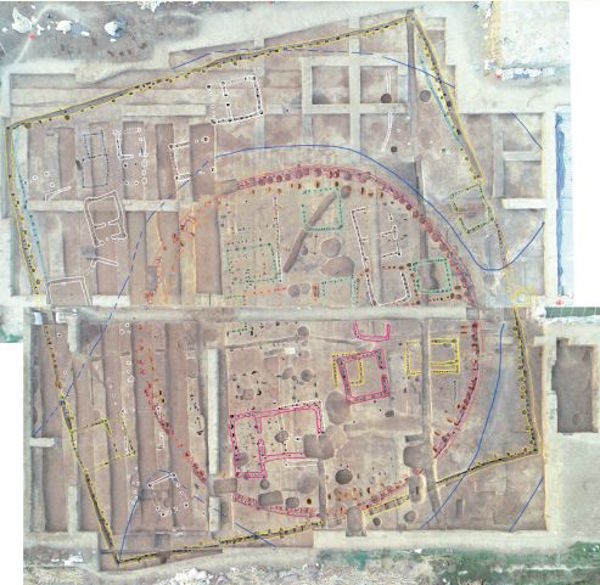
Distribution map of Longshan cultural relics in Ximengzhuang site
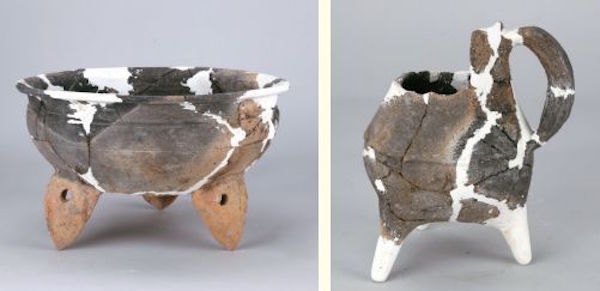
Pottery Ding and Pottery Stems Unearthed from Ximengzhuang Site
Ximengzhuang site reveals a relatively well-preserved Longshan cultural settlement with a clear structure. It is found that the fence, ring ditch, house site, ash pit, tomb, kiln site and a large number of column caves are regularly distributed and combined, forming a walled settlement. It can be divided into two stages, the lower square fence stage and the upper round fence stage. The square fence was built in the early Longshan period, and it was used until the early Longshan period, and the early and late Longshan period was replaced by the circular fence, which lasted until the middle Longshan period. If this reflects a form of grass-roots settlement at that time, it will provide valuable information for us to understand the structure of Longshan cultural grass-roots settlement and interpret people’s life and career patterns in Longshan cultural grass-roots settlement. If this is a special settlement, it is very important to identify its nature. It reveals for the first time that there has been functional differentiation in the non-economic sense in the settlement during the Longshan culture period, which is very important for us to analyze and evaluate the degree of social development at that time.
Honghe Site, Qiqihar City, Heilongjiang Province
(Heilongjiang Institute of Cultural Relics and Archaeology)

Remains of Xia, Shang and Neolithic Age in Eastern Region
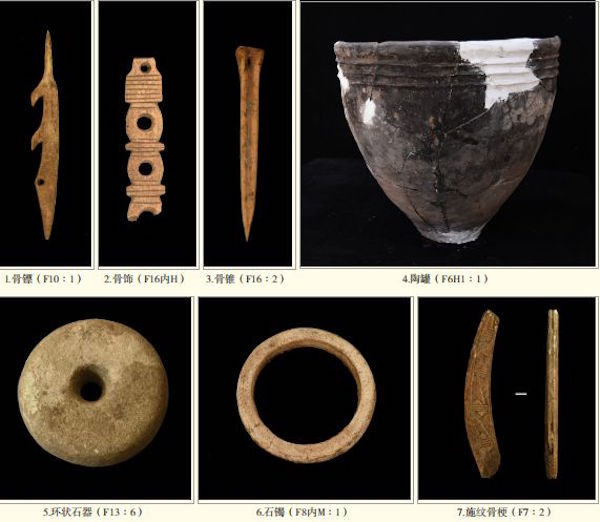
Neolithic relics unearthed from the site
Four excavations in 2017 and before made it clear that the Neolithic remains of Honghe site belong to the same kind of remains as Ang ‘angxi culture, which is a typical site of Ang ‘angxi culture and the central settlement of Ang ‘angxi culture. During the fifth excavation in 2018-2019, 12 houses of Angangxi culture in the late Neolithic Age, 1 house in Xia and Shang Dynasties, 12 houses of Baijinbao culture in two weeks and 81 tombs in Qing Dynasty were cleared. By dissecting and cleaning three ring trenches in the late Neolithic Age and their Tongjiang sections, the shape and structure, excavation and construction time, excavation and construction process, use and abandonment process were basically clarified. It is the first time to reveal and clarify the form of prehistoric settlements in Nenjiang River Basin, which is of great significance to the settlement research of prehistoric archaeology in China. The appearance of the ring trench and the use of large-scale houses indicate that the fishing and hunting civilization in the Nenjiang River basin existed a settlement model in the late Neolithic period. Shortened the time difference between the social development process of Nenjiang River basin in the late Neolithic period and the core area of Chinese civilization at the same time. The Nenjiang River basin entered the civilized society more than a thousand years earlier, and then the civilization history of Heilongjiang River basin was rewritten.
Ruins of Huangchengtai Tai Foundation in Shimao Site, Shenmu City, Shaanxi Province
(Shaanxi Archaeological Research Institute, Yulin Cultural Relics Archaeological Exploration Team, Shenmu Shimao Site Management Office)
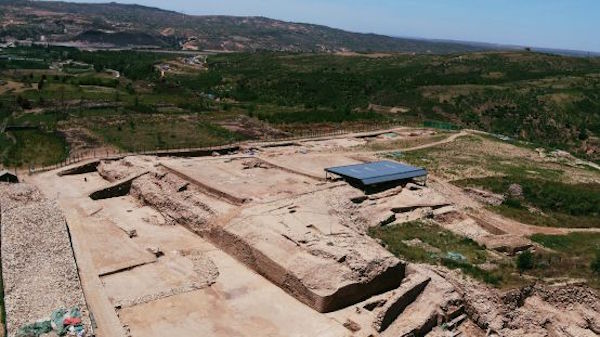
Huangchengtai Taiji
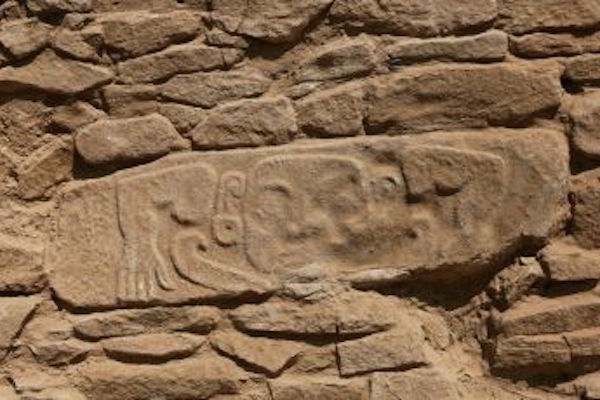
South retaining wall no.6 stone carving
The Shimao site consists of the Imperial Terrace, the inner city and the outer city, with an area of more than 4 million square meters. It is the largest known city site in China in the late Longshan period and the early Zhixia period. In 2018, a large-scale building abutment was discovered in the east of Huangchengtaiding, on which a large number of building bases were distributed, temporarily called "Dataiji". After excavation in 2018-2019, the outline of the foundation of the large platform gradually became clear. The plane of the foundation of the large platform is roughly square with rounded corners, and the side length is about 130 meters. The core of the platform is rammed and surrounded by stone walls. At present, the south retaining wall and surrounding areas of the foundation of the large platform are basically completely exposed, and the positions of the west retaining wall and the north retaining wall are confirmed. More than 70 exquisite stone carvings were found in the south retaining wall, and some of them were embedded in the wall of the south retaining wall. The age of construction and use of Tai Tai Ji should be no later than 2000 BC, and the age of stone carving should be no later than 2000 BC. The phenomenon of inlaid stone carvings on the wall should have the same spiritual connotation as that found in the ruins of Shigao, and it reflects the spiritual sustenance of the ancestors of Shigao on the grand platform of the Imperial City. The discovery and confirmation of Dataiji officially opened the curtain of discussing the settlement division and functional nature of Huangchengtai, which laid an important material foundation for the core position of Huangchengtai in the city site of Shimao.
Xiwubi Site in Jiangxian County, Shanxi Province
(Archaeological Institute of China National Museum, Shanxi Institute of Archaeology, Yuncheng Institute of Cultural Relics Protection)
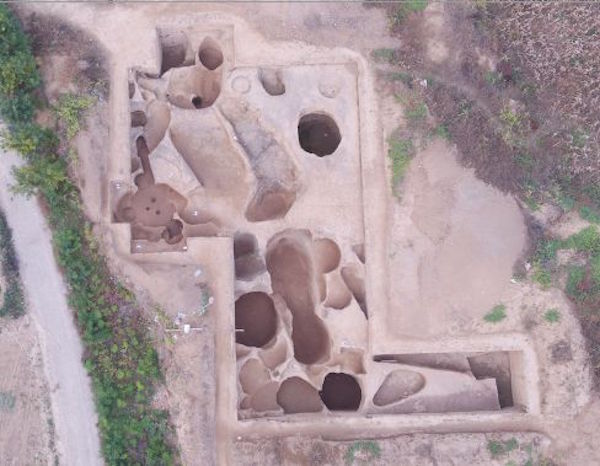
Excavation area in the east of Xiwubi site (north above)
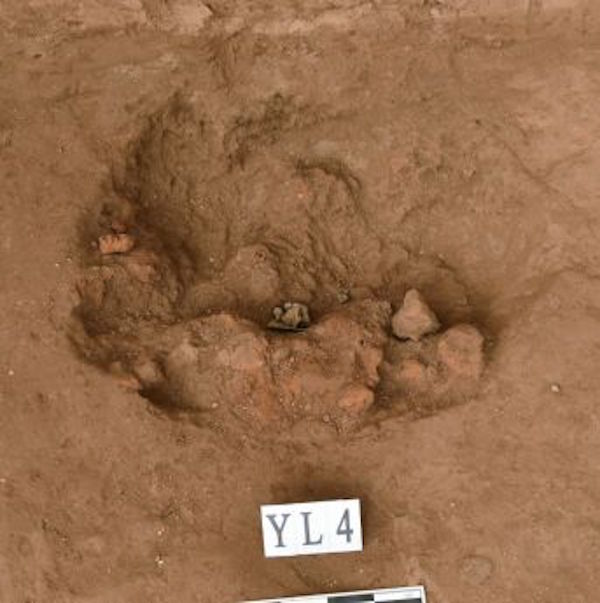
Remnants of copper smelting furnace in Erligang period
The distribution area of Erlitou and Erligang remains of Xiwubi site is about 700,000 square meters. The central area is located in the east of the site, covering an area of about 400,000 square meters, including the residence and burial area in the north, and the concentrated distribution area of copper smelting remains in the south of the middle, covering an area of 100,000 square meters. A large number of relics and relics of Longshan, Erlitou, Erligang, Zhou and Song dynasties were obtained, among which the copper smelting remains of Erlitou and Erligang periods were the most important. In the ash pits of Erlitou and Erligang periods, residual pottery and stone patterns were also found for casting small tools, indicating that the Xiwubi site can also cast some tools besides smelting copper. The newly discovered Erlitou charcoal kiln, Erligang lower copper smelting furnace, and other copper smelting relics of Erlitou and Erligang periods, together with the previously discovered copper smelting relics, enrich the connotation of Xiwubi site, showing a large-scale and highly specialized copper smelting workshop form, which provides valuable physical materials for in-depth study of the early copper smelting handicraft technology and production methods, and even explores the relationship between the rise of Xia and Shang Dynasties and the control, development and utilization of copper, a strategic resource.
Zizhulin Chunqiu Zengguo Noble Cemetery, Suizhou City, Hubei Province
(Hubei Institute of Cultural Relics and Archaeology, Peking University, Suizhou Museum, Zengdu District Archaeological Team)
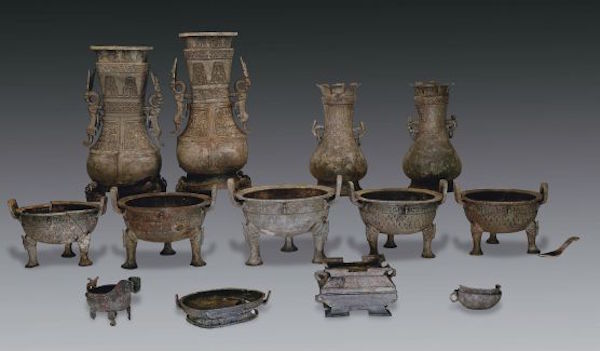
M190 (Zeng Gongqiu) bronze ritual vessel combination
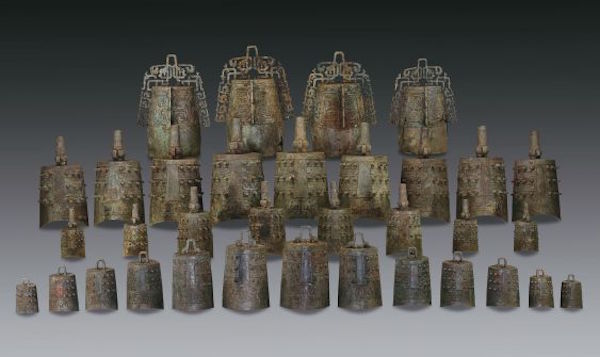
M190 (Zeng Gongqiu) bronze chime combination
The archaeological team excavated 86 tombs of Zeng State in the Spring and Autumn Period. There were 5 large tombs in the shape of A, 19 medium tombs and 62 small tombs. Among them, five A-shaped tombs are arranged in three groups from north to south. The owners of the three groups of tombs are Zeng Gongqiu and his wife Yu, Zeng Houbao and his wife Mi Jia and Zeng Houde respectively. More than 2,000 bronzes were unearthed in the cemetery, including nearly 600 bronze ritual instruments, and the inscriptions of bronze ritual instruments were found to be nearly 6,000 words, which is the largest batch of bronze inscriptions in the Spring and Autumn Period discovered by archaeology in the new century. Zaoshulin Cemetery made up for the missing link of Zeng State in the mid-Spring and Autumn Period, constructed the most important cultural sequence of Fengzhong State in the Zhou Dynasty in China with the most complete archaeological materials, and constructed a scale of bronze culture in Jianghan area, which was of great significance in the archaeological field of Zeng State and even two weeks.
Mural Tomb in Quangou Tubo Period, Wulan County, Qinghai Province
(Institute of Archaeology, Chinese Academy of Social Sciences, Ethnic Museum, Haixi Autonomous Prefecture, Qinghai Province, Wulan County Bureau of Culture, Sports, Tourism, Radio and Television)
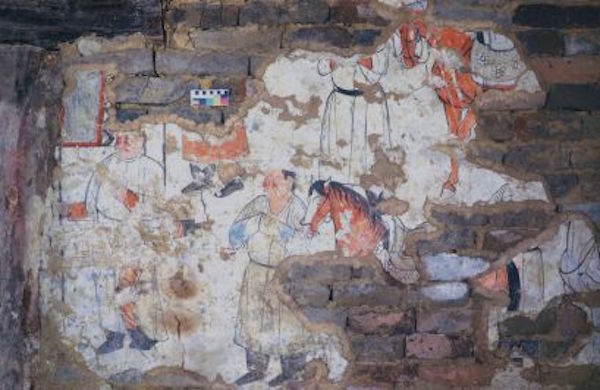
Ma Yingbin diagram of anterior chamber eastern wall
The mural tomb (Tomb No.1) is a rectangular brick-wood mixed structure multi-chamber tomb with a tomb passage. The tomb consists of a front room, a back room and two side rooms. The mural on the side of the front room tomb door is about leading Ma Yingbin warriors. Other murals include hunting, feasting and dancing, and the top depicts all kinds of birds and animals. A hidden compartment was found on the pit wall at the bottom of the tomb outside the wooden coffin on the west side of the back room, which contained a rectangular wooden box with a pearl crown, a dragon, a phoenix, a lion and a gold cup inlaid with turquoise.
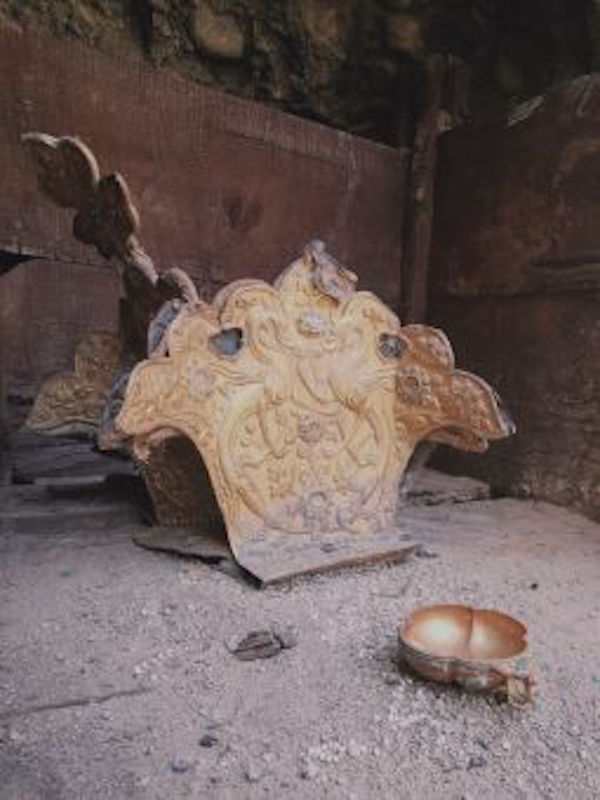
Gold-plated crowns and cups in concealed wooden cases
According to the characteristics of unearthed relics and the style of mural content, it is inferred that the tomb was in the Tubo period and the carbon fourteen date was in the eighth century AD. The No.1 Tomb in Quangou is the only mural tomb in Tibetan Plateau so far. The tomb owner may have a close relationship with the local royal family during the Tubo period, indicating that there was a high-level administrative and military establishment in the northern margin of Qaidam Basin during the Tubo period. Tombs show a strong dual influence of Tang Wenhua and Tubo culture, which is of great academic value for discussing the process of Sino-Tibetan cultural integration and the grand occasion of cultural exchange along the Silk Road in Qinghai.
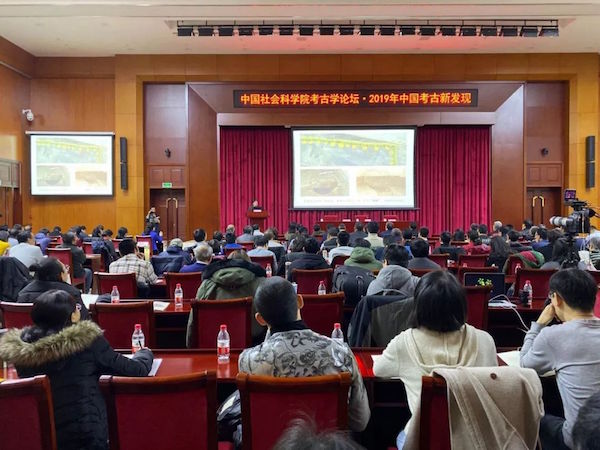
Meeting site
In addition to the above-mentioned six new archaeological discoveries in China in 2019, seven finalists were selected, namely: the Paleolithic site of Mangedong, Hanzhong City, Shaanxi Province, the Neolithic site of Qiaotou, Yiwu City, Zhejiang Province, the Neolithic site of Simagou, Huade County, Inner Mongolia, the Korean Eastern Zhou Cemetery in Tengzhou City, Shandong Province, the Han Tomb in Hujiacaochang, Jingzhou City, Hubei Province, the Shancheng site of Mopan Village, Tumen City, Jilin Province, and the Shifosi site in jiangjin district, Chongqing. In addition, as one of the achievements of China’s archaeological "going out", the archaeological project of Natishwa site in the ancient city of Biheropur, Bangladesh, which was jointly carried out by Hunan Institute of Cultural Relics and Archaeology and Otia Oneisen Archaeological Research Center of Bangladesh, was selected as a new foreign archaeological discovery in 2019.
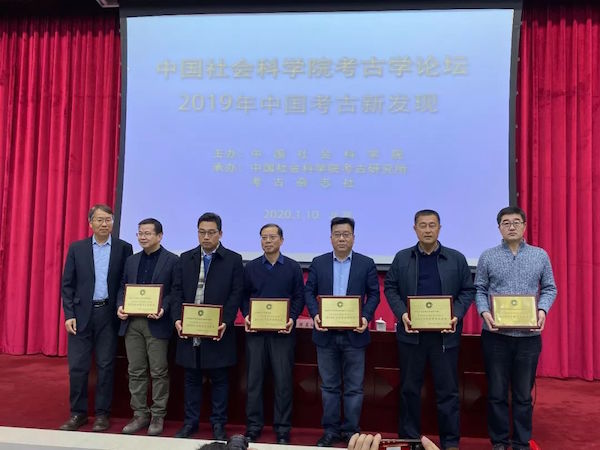
Chen Xingcan, director of the Institute of Archaeology, Chinese Academy of Social Sciences, presented certificates to the selected project representatives.
(According to China Archaeological Network, Institute of Archaeology, China Academy of Social Sciences)